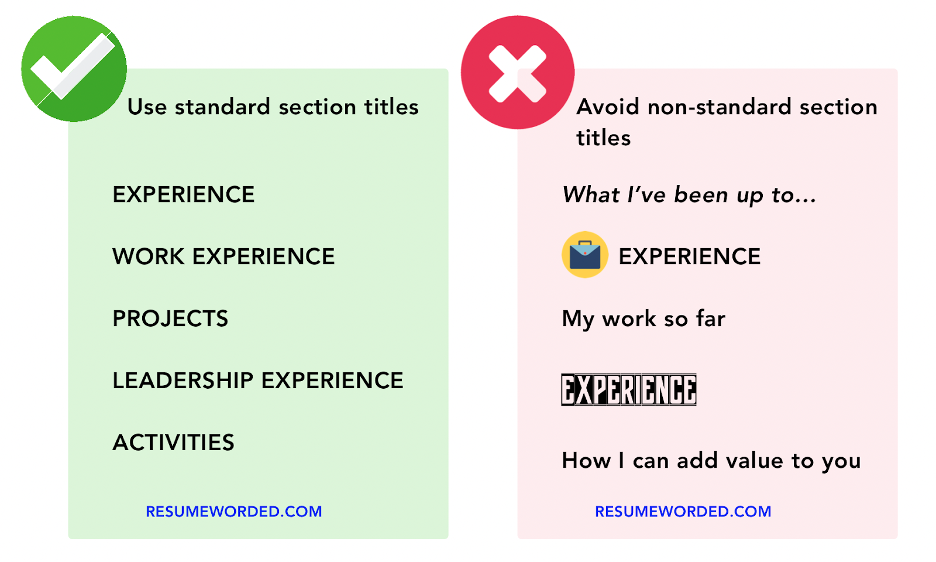If you’re applying for a senior-level role or one that involves managing others, hiring managers will be looking for evidence of leadership skills. That part’s pretty straightforward — what’s less straightforward is communicating those skills on your resume.
Unlike hard skills like programming or foreign language proficiency, leadership is a soft skill, which means you can’t simply list it in your skill section and move on. So, how do you demonstrate leadership on your resume?
Quick guide to showing leadership skills on your resume
Here's our quick-start guide to listing leadership skills on a resume:
- Look at the job description you're applying for to get a sense of what specific leadership skills you need.
- Start each bullet point accomplishment with a strong action verb.
- Explain a task or project and what your role was.
- Include metrics to show the impact of what you accomplished.
- Highlight positions of leadership in your resume title and summary.
- Get personalized feedback on any potential areas of improvement before you hit "submit" by running your resume throguh our Resume Scanner.
Here’s a good example of how to show soft skills like leadership on a resume:
What recruiters really want when they ask for leadership skills
Showing leadership is more than just saying that you once managed a team (though that’s a great place to start). When recruiters ask for good leadership skills, they’re really asking for a range of soft skills, such as:
- Decision making
- Problem solving
- Delegation
- Motivation
- Managing employees
- Team building
- Communication
- Conflict resolution
- Risk taking
The best way to know exactly what leadership skills a recruiter is looking for is to check the job description. For each role mentioned in the job ad, tailor your resume to include a bullet point that demonstrates that particular skill.
For example, if the job description mentions "motivation,” you could show this by saying that you "spearheaded an employee engagement program, resulting in a 10% decrease in annual employee turnover." If the job description mentions "setting goals,” you could say you "conducted yearly performance reviews and established goals, increasing efficiency by 10%."
How to show leadership skills on your resume
Once you’ve determined what skills the job is asking for, here’s how to describe your leadership skills on your resume.
Start with a strong action verb
Always start your statements with a strong action verb. Verbs like “led, launched, directed, and spearheaded” all paint a picture of a proactive leader, which is what you’re aiming for. Need help brainstorming? Our action verbs database has more examples you can use to boost your resume.
Be specific
If you’re applying for a leadership role, focus on accomplishments that show how you’ve demonstrated leadership skills in previous positions. Increasing revenue, coordinating stakeholders, managing a team, and acquiring new talent are all things that employers will want their senior-level staff to do, which makes them perfect additions to a resume. The more specific you can be, the better. For example:
Bad: Increased productivity.
Okay: Increased productivity by discovering and sharing new techniques.
Excellent: Increased productivity by 20% by becoming a subject matter expert on a new automated tracking tool and sharing it with the team.
Use bullet points
Always use bullet points to describe your experience. This makes your resume easier to skim and less cluttered. Your bullet points should focus on high-level outcomes rather than individual responsibilities and be relevant to the role you’re applying for.
Quantify your skills
Quantifying skills simply means turning your experience into a measurable statement that reflects the positive impact of your work. Think of it as backing up your claims with hard facts and impressive statistics. Here’s how to quantify your leadership skills:
- Identify a key achievement: Reflect on your previous roles and choose an impressive accomplishment, project, or task that involved leadership. Did you lead a project, increase efficiency, or improve team morale?
- Describe the scope of the project: How many people were under your leadership? What was the budget of the projects? These figures provide a scale to your leadership role.
- Show the positive result: Look for concrete metrics that demonstrate the impact of your leadership. Did your strategies increase sales, reduce costs, or improve customer satisfaction? Use percentages or financial figures to illustrate these achievements.
For example, rather than saying, “Led a team,” say that you “Led a team of 12, achieving a 30% increase in productivity over six months.”
Let's take a look at another example of how to quantify leadership skills:
Find out if your resume shows leadership
Once you’ve finished, upload your resume to the tool below. It’ll rate you on core competencies — including leadership skills — and give you instant feedback on how to optimize your resume to land the job you want.
Where to show leadership skills on your resume
You can showcase your leadership skills in various sections of your resume, including your work experience, resume summary, and resume header.
In your work experience section
Your work experience section is the most common and most crucial area to showcase your leadership skills. Each past role should detail specific accomplishments through bullet points, using quantifiable outcomes to demonstrate the positive impact of your leadership.
Here is an example of a resume showcasing leadership skills under work experience:
In your resume summary
Including a resume summary is optional, but can be a good idea if you're trying to highlight a specific skill, like leadership. A resume summary should go above your work experience and be limited to 3-5 lines. Be sure to include any key skills and standout accomplishments, including specifics about the size and context of previous teams you've led.
In your resume header
If you want your leadership skills to be the prominent focus of your resume, include them in your resume header. Using a professional title that reflects your experience, such as 'Strategic Team Leader,’ or ‘Project Leader’, indicates to the reader that leadership is a key component of your experience and skills.
How to show leadership skills outside of a professional setting
Leadership isn't only confined to traditional job roles. If you don’t have much paid experience with leadership, don’t worry; you can demonstrate leadership through various activities, including volunteer work, personal projects, freelance or contract work, and virtual or remote settings.
Volunteer and community work
Volunteer and community work can be a great way to showcase leadership. Focus on organization skills, emphasizing event planning, team coordination, communication, and public speaking. Quantify your experience with statistics, such as the number of people involved, the amount of money raised, and the scale of the project.
For example:
Led a team of 20 volunteers in a city-wide clean-up, collecting over 1,000 pounds of litter.
Personal Projects
Personal projects are excellent for demonstrating self-motivation and creativity, both of which are key leadership traits. Describe the project's scope, your role in its development, and any significant outcomes. If your project led to notable results, like receiving an award or recognition, highlight it.
For example:
Independently developed and managed a comprehensive digital art portfolio, showcasing a collection of over 50 original artworks.
Freelance and Contract Work
In freelance and contract work, leadership is often demonstrated through effective client management and the ability to multitask across various projects. Discus skills such as managing client expectations, meeting tight deadlines, and resolving conflicts to show leadership, adaptability, and organizational skills.
For example:
Managed a diverse client base, successfully delivering over 30 web development projects within budget and deadlines over two years.
Virtual and Remote Work
Leadership in virtual and remote work settings is becoming increasingly crucial in today's work environment. Highlight experiences where you've successfully managed or coordinated remote teams, focussing on effective communication, timely project completion, and achieving set goals. Emphasize the results, such as improved team performance, successful project outcomes, or innovative remote collaboration, to showcase your effectiveness as a virtual leader.
For example:
Led a remote team of 15 members across five countries in executing a major marketing campaign for an international product launch.
What not to do: Avoiding common mistakes
Don't use leadership buzzwords
Buzzwords are overused words and phrases, like “creative thinker” or “good team player,” that take up space on your resume without saying anything about your actual skills or experience. Instead, replace buzzwords with accomplishments that demonstrate skills in action.
Don't list soft skills as skills
Soft skills like leadership, communication, and time management don’t belong in your skills section. You need to show a recruiter proof of these skills through quantified experience rather than simply listing them as skills. Your resume skills section should be reserved for hard skills, such as technical expertise, digital tools, languages, and programming skills.
Don't repeat yourself
If your eyes are starting to glaze over after the fifth time you've started a sentence with "Led ..." the hiring manager is likely skipping over it, too. Avoid repetition by using appropriate synonyms for the specific skills you're trying to convey. For example:
If you spearheaded a project: Initiated, Established, Pioneered, Launched, Organized
If you managed employees: Supervised, Ran, Directed, Headed, Delegated
If you led coaching or training: Mentored, Trained, Coached, Guided, Motivated
Don’t forget Keywords
Including the right keywords is crucial for a high-performing resume - Not only to show a recruiter why your experience is relevant but to get your resume past ATS. While leadership is an important thing to showcase, “Leadership” itself is not a keyword. Keywords tend to be hard skills and qualifications, while soft skills are evaluated by a recruiter rather than ATS.
Use the job description to find relevant keywords to include in your resume, or use a keyword finder to generate a list of must-include words. If you need help finding hard skills and keywords relevant to the leadership role you’re applying for, use the tool below to find competitive keywords for your industry.
Don't exaggerate your leadership experience
It’s important not to overstate your experience when trying to show leadership. Over-exaggerating your skills can harm your professional reputation and lead to unrealistic expectations once you start the job.
Use specific examples and quantifiable achievements to represent your leadership experience honestly; for example, if you led a small team on a project, don't imply that you were overseeing an entire department.
If your leadership opportunities have been limited, focus on potential and growth rather than exaggerating past roles. Highlighting real instances where you showed leadership qualities, even in smaller tasks or projects, can be more impactful than overstated claims.
Examples of leadership skills on a resume
Here are some leadership skills examples for your resume, whether you’re just starting out in a leadership role or applying for an executive-level position.
Entry-level: If you’re just starting out in leadership
Not all leadership skills involve managing others. Promotions demonstrate your commitment and ability to add value to the company, which all hiring managers are looking for.
Promoted within 12 months due to strong performance and organizational impact (one year ahead of schedule).
If you’ve never led your own team, you can still show leadership skills and your ability to manage others through accomplishments like coaching, mentoring, and leading individual projects.
Coached 3 summer interns and submitted final performance evaluations.
Show that you can do the day-to-day work of management by detailing the number of people in the teams you’ve led or the size of the company. This is true even if you’ve only led small teams to date — if you’re applying for a job leading a much larger team or facility, you can address that in your cover letter.
Hired and trained team of six employees with two direct reports; promoted 6 months ahead of schedule
Mid-Level: If you have some leadership experience
The ability to take initiative is an important aspect of leadership. You can highlight this even without direct leadership experience by describing a time you spearheaded a new development and what the results were.
Drove redevelopment of internal tracking systems in use by 125 employees, resulting in 20+ new features, reduction of 20% in save/load time and 15% operation time
Good leaders are also effective communicators. This is another soft skill that doesn’t belong on a list, but you can demonstrate it by mentioning what you did in terms of outreach, management, or external partnerships, and what benefit it had to the company.
Managed business development opportunities that resulted in a 45% increase in partnerships.
Recruiters are looking for leaders who understand their business and are able to help it grow. Emphasize this skill by including accomplishments related to business development, strategy, and analysis.
Developed strategic insights across 5 product teams, including revenue, marketing and operations departments.
Senior-level: If you’re applying for high-level leadership positions
The best thing you can do to demonstrate your leadership experience is to be specific. What exactly did you do? What aspects of running the business were you in charge of? What was the scope of your work? The more detailed your metrics are, the more impressive your accomplishments will be.
Directed agency fundraising revenue generation, daily program business operations, community outreach membership recruitment, and human resources in 30 suburbs in the city for organizations with assets of $8M.
If you’re applying for a high-level position, you need high-level accomplishments. Launching an office shows that you can lead new developments while the increase in revenue emphasizes that you can do it effectively.
Launched Miami office with lead Director and recruited and managed new team of 10 employees; grew office revenue by 200% in first nine months (representing 20% of company revenue).
Another crucial aspect of high-level leadership is the ability to drive the company forward. Developing new strategic goals in addition to achieving existing ones shows your ability to be proactive, not just reactive.
Worked with CEO and 5 development team members to plan strategic goals to grow as a global company in the next 3 years.
How to show both leadership skills and teamwork on your resume
Demonstrating a balance of leadership and teamwork on your resume is essential, as it shows you’re capable of leading while also being an active team member.
Highlight examples where you led projects or initiatives, emphasizing your role in guiding and inspiring team members. Showcase times when you contributed as a part of a team, supported team goals, helped resolve conflicts, or played a key role in achieving a group objective.
For example:
Spearheaded a marketing campaign, leading a team of 5, which resulted in a 20% increase in sales.
As Project Lead, directed a team of 6 in the comprehensive redesign of a major e-commerce website, enhancing user experience and functionality.
How to show the progression in leadership skills
Showing the progression of your leadership skills is key to demonstrating adaptability and growth on your resume. Start by highlighting early leadership experiences, showing how your skills have developed from initial roles to more complex responsibilities.
For example, you might begin with examples of leading small projects or teams and progress to managing more significant initiatives. Emphasize how you adapted to different challenges and learned new strategies over time. This could include transitioning from a hands-on leadership style to a more strategic role, or learning to lead remote teams effectively.










